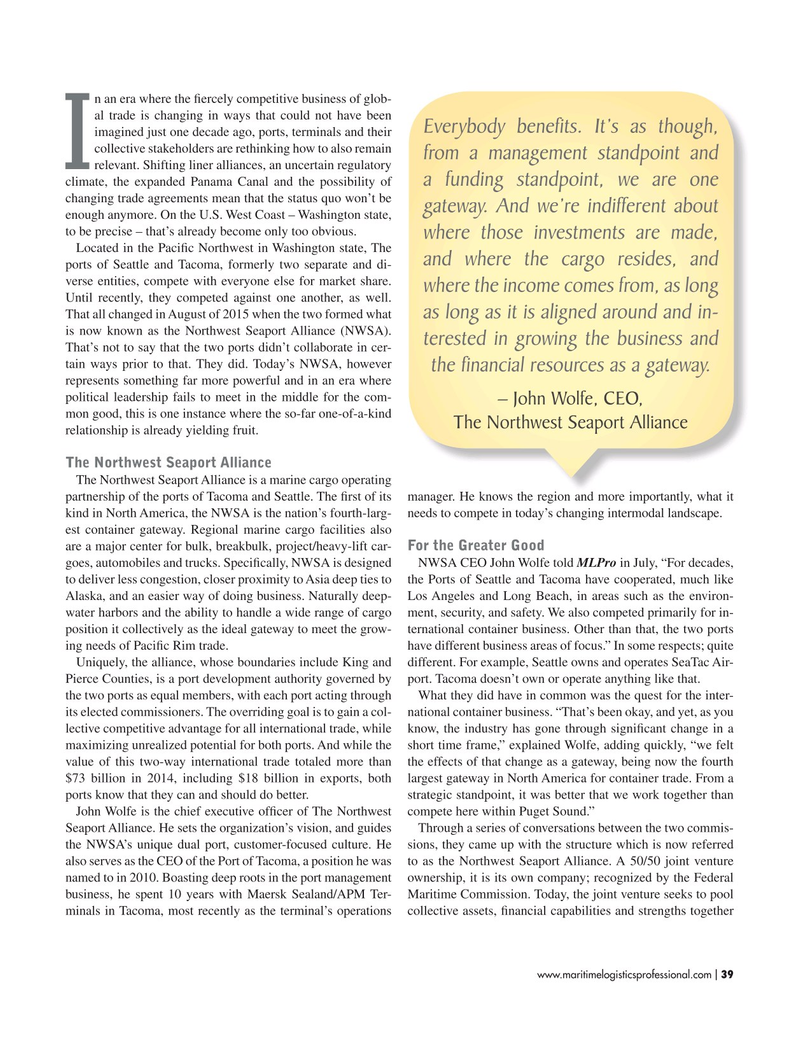
Page 39: of Maritime Logistics Professional Magazine (Jul/Aug 2017)
PORTS & INFRASTRUCTURE
Read this page in Pdf, Flash or Html5 edition of Jul/Aug 2017 Maritime Logistics Professional Magazine
n an era where the fercely competitive business of glob- al trade is changing in ways that could not have been
Everybody benefts. It’s as though, imagined just one decade ago, ports, terminals and their collective stakeholders are rethinking how to also remain from a management standpoint and
Irelevant. Shifting liner alliances, an uncertain regulatory climate, the expanded Panama Canal and the possibility of a funding standpoint, we are one changing trade agreements mean that the status quo won’t be gateway. And we’re indifferent about enough anymore. On the U.S. West Coast – Washington state, to be precise – that’s already become only too obvious.
where those investments are made,
Located in the Pacifc Northwest in Washington state, The and where the cargo resides, and ports of Seattle and Tacoma, formerly two separate and di- verse entities, compete with everyone else for market share. where the income comes from, as long
Until recently, they competed against one another, as well.
That all changed in August of 2015 when the two formed what as long as it is aligned around and in- is now known as the Northwest Seaport Alliance (NWSA). terested in growing the business and
That’s not to say that the two ports didn’t collaborate in cer- tain ways prior to that. They did. Today’s NWSA, however the fnancial resources as a gateway. represents something far more powerful and in an era where political leadership fails to meet in the middle for the com- – John Wolfe, CEO, mon good, this is one instance where the so-far one-of-a-kind
The Northwest Seaport Alliance relationship is already yielding fruit.
The Northwest Seaport Alliance
The Northwest Seaport Alliance is a marine cargo operating partnership of the ports of Tacoma and Seattle. The frst of its manager. He knows the region and more importantly, what it kind in North America, the NWSA is the nation’s fourth-larg- needs to compete in today’s changing intermodal landscape. est container gateway. Regional marine cargo facilities also are a major center for bulk, breakbulk, project/heavy-lift car-
For the Greater Good goes, automobiles and trucks. Specifcally, NWSA is designed NWSA CEO John Wolfe told MLPro in July, “For decades, to deliver less congestion, closer proximity to Asia deep ties to the Ports of Seattle and Tacoma have cooperated, much like
Alaska, and an easier way of doing business. Naturally deep- Los Angeles and Long Beach, in areas such as the environ- water harbors and the ability to handle a wide range of cargo ment, security, and safety. We also competed primarily for in- position it collectively as the ideal gateway to meet the grow- ternational container business. Other than that, the two ports ing needs of Pacifc Rim trade. have different business areas of focus.” In some respects; quite
Uniquely, the alliance, whose boundaries include King and different. For example, Seattle owns and operates SeaTac Air-
Pierce Counties, is a port development authority governed by port. Tacoma doesn’t own or operate anything like that.
the two ports as equal members, with each port acting through What they did have in common was the quest for the inter- its elected commissioners. The overriding goal is to gain a col- national container business. “That’s been okay, and yet, as you lective competitive advantage for all international trade, while know, the industry has gone through signifcant change in a maximizing unrealized potential for both ports. And while the short time frame,” explained Wolfe, adding quickly, “we felt value of this two-way international trade totaled more than the effects of that change as a gateway, being now the fourth $73 billion in 2014, including $18 billion in exports, both largest gateway in North America for container trade. From a ports know that they can and should do better. strategic standpoint, it was better that we work together than
John Wolfe is the chief executive offcer of The Northwest compete here within Puget Sound.”
Seaport Alliance. He sets the organization’s vision, and guides Through a series of conversations between the two commis- the NWSA’s unique dual port, customer-focused culture. He sions, they came up with the structure which is now referred also serves as the CEO of the Port of Tacoma, a position he was to as the Northwest Seaport Alliance. A 50/50 joint venture named to in 2010. Boasting deep roots in the port management ownership, it is its own company; recognized by the Federal business, he spent 10 years with Maersk Sealand/APM Ter- Maritime Commission. Today, the joint venture seeks to pool minals in Tacoma, most recently as the terminal’s operations collective assets, fnancial capabilities and strengths together www.maritimelogisticsprofessional.com 39
I

 38
38

 40
40
